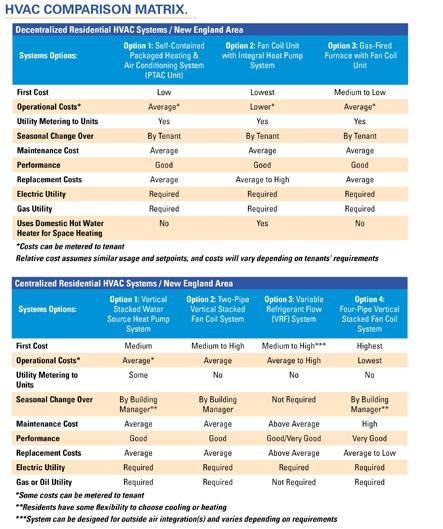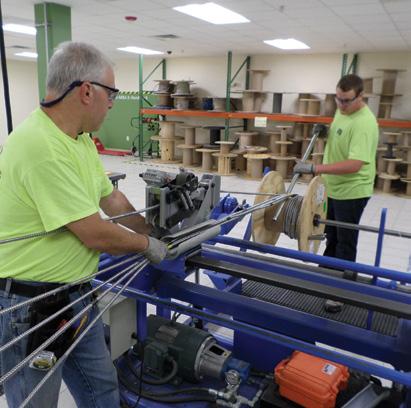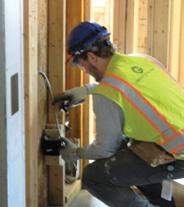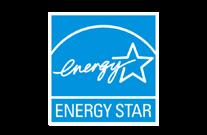Annual Supplement: Building Energy / MEP









Annual Supplement: Building Energy / MEP








Potsdam, NY – Fitzemeyer & Tocci Associates, Inc. announced that the Regional Care Pavilion expansion and modernization project at Canton-Potsdam Hospital has reached a key stage, with the addition now enclosed and infrastructure installations progressing across the four floors. Fitzemeyer & Tocci Associates is providing mechanical, electrical, plumbing and fire protection (MEP/FP) engineering and construction administration services on the project.
Designed by LaBella Associates, the nearly 100,000sf project seeks to modernize patient care with a new welcoming and more accessible main entrance and lobby; private, singleoccupancy patient rooms; an expanded emergency department to increase capacity and efficiency of care; and shell


space reserved to further enhance the diagnostic imaging services in the future.
Key components of the MEP upgrades are in place, including air handlers and chillers on the roof, and the new penthouse mechanical room heating plant is coming online with new dual fuel boilers to support the entire hospital and significantly increase the efficiency of the facility’s heating and cooling systems. New domestic water heating utilizes high-efficiency heat exchangers fed from the new main boiler plant. A new, dual fed utility electric service installed with the expansion will support the entire facility, provide increased reliability, and together with a separate existing facility electrical upgrade project, reduce the maintenance burden on the facilities team.
Other major equipment continues to arrive, and the construction team, spearheaded by Pike Construction, is gearing up for tie-ins to the existing hospital infrastructure. While many of the new infrastructure will be interfaced with the existing building as part of this project, the design also includes extensions of piping and ductwork to accommodate future upgrades to existing hospital space with minimal impact or shutdowns.
The design includes the ability to convert standard patient rooms on the



second floor into negatively pressurized rooms to create additional isolation spaces for airborne infection control when and if the need arises. Each room has individual temperature control through the BMS, enhancing the ability to meet the needs of both the facility and patient comfort. Existing staffing will relocate into the new
space, and the move to single-occupancy rooms will better accommodate the hospital’s current patient load. This also provides the opportunity for existing patient units MSU2 and MSU3 beds to be repurposed as 18-bed single-occupancy surge units, providing flexibility for potential patient surge volumes.
Founded in 1951, the third generation of the Wilkinson family continues to provide the highest standards of installation, service, and maintenance for all your boiler room needs.

We have New England’s largest fleet of mobile boilers. Steam, hot water, domestic hot water—you’re covered. Need one that fires oil or natural gas?
have those too. Our dependable mobile boilers, available in many sizes, will get you up and running with minimal disruption.





 by Eric Greene
by Eric Greene
The design process for multifamily residential developments involves numerous decisions, some based on developer preference and others on state and local code requirements. Among these decisions, choosing the right HVAC system is crucial and should be made early on. There are two main categories of HVAC systems: Decentralized and Centralized.

Decentralized systems are often preferred for low and mid-rise buildings due to their affordability and flexibility. These systems, such as Self-Contained Packaged Heating & Air Conditioning
(PTAC) units, offer individual unit control but may require more frequent maintenance and have a shorter lifespan compared to centralized systems.
The Fan Coil Unit with Integral Heat Pump System and Gas-Fired Furnace with Fan Coil Unit are other options within decentralized systems, offering varying levels of efficiency and cost.
Centralized systems, on the other hand, serve the entire building from a central location and are typically used in mid to high-rise buildings. They are more expensive to install but offer more sophisticated control and maintenance options. Options like the Vertical Stacked Water Source Heat Pump System and Variable Refrigerant Flow (VRF) System provide flexibility and energy efficiency but come with higher initial costs.
The choice between centralized and decentralized systems depends on factors such as building size, budget, and desired level of control and comfort. Understanding the pros and cons of each system is essential in making the right decision for your project. Erland offers expertise in guiding developers and design partners through this decision-making process for multifamily residential properties, ensuring the project’s success.
Eric Greene is vice president, residential group manager at Erland Construction.
Boston – Massachusetts Clean Energy Center (MassCEC) recently announced $2.5 million in funding for 18 clean energy and climatetech companies and researchers. The funding, which comes from the MassCEC’s Catalyst, Diversity in Cleantech – Early Stage (DICES), and InnovateMass programs, will support clean energy and climatetech innovators in 11 cities and towns throughout Massachusetts, including Somerville, Cambridge, Boston, Brookline, Stow, Billerica, Springfield, Worcester, Boxford, New Bedford, and Canton.
“These grants will infuse earlystage companies and researchers with the funding they need to develop their climate technologies and attract further investment,” said Massachusetts Clean Energy Center CEO, Dr. Emily Reichert.
“Our goal is to make Massachusetts the climate innovation lab for the world, and that means creating an environment where climatetech businesses can start, stay and scale. Our tech-to-market grants, administered in partnership with MassVentures, are designed to help innovators test and demonstrate their climate solutions. Governor Healey’s Mass Leads Act would build on this success and help these companies thrive, creating good-paying jobs for our residents.”
As a complement to the grants and


support for technology developers, MassCEC also recently awarded $513,500 to six Massachusetts-based accelerator programs focused on supporting climatetech innovators: Activate Boston (Cambridge), Berkshire Innovation Center’s Stage2 Program (Pittsfield), Cleantech Open Northeast (Somerville), Lever’s Berkshire Sustainability Challenge (North Adams), FORGE (Somerville), and Y Innovation Studios (Lynnfield).
Awardees include:
• Sublime Systems, Inc., Somerville, Mass. – $124,887 to test its emissionfree cement production technology with Boston Sand and Gravel.
• BootBox Labs, Inc., Boxford, Mass. –$350,000 to demonstrate its refrigerantfree, low-energy usage air conditioners and heat pumps at apartments in Massachusetts in collaboration with
RantAnAC.com.
• MetalMark Innovations, PBC, Cambridge, Mass. – $136,262 to demonstrate its commercial air purification system to improve indoor air quality and to reduce HVAC energy with the Chariho Regional School District in Rhode Island.
• StepWise Electric Inc., Somerville, Mass. – $341,600 to test its energy management technology for homes and to accelerate the adoption of residential EV charging at various Massachusetts residential homes.
• Smart Solar Electric Heating, LLC, Canton, Mass. – $200,000 to demonstrate its solar assisted heat pump water heater at several low-to moderateincome homes in Massachusetts.
• Active Surfaces, Somerville, Mass. –$75,000 to develop its light weight and flexible solar panels to be used on more difficult to install building surfaces, like
bumpy rooftops.
• Adhesion Technologies, Cambridge, Mass. – $75,000 to develop its sustainable and cost-competitive wood adhesive made from corn ethanol waste.
• Worcester Polytechnic Institute (Dr. Yan Wang), Worcester, Mass. – $75,000 to develop a recycling process for recovering valuable chemicals and metals from discarded solar panels.
• Benchmark Labs, Inc., Somerville, Mass. – $75,000 to develop its solution that uses a combination of sensors, advanced software technology, and weather information to deliver forecasts, recommendations and alerts, customized to a specific location to save costs when installing and maintaining offshore wind farms.
Additional awardees include Aloft Systems, Inc., Boston, Mass. ($350,000); Stec Technology, Inc., New Bedford, Mass. ($220,00); Deep Anchor Solutions, College Station, Texas ($59,620); ThermoBionics, Boston, Mass. ($75,000); MacroCycle Technologies, Cambridge, Mass. ($75,000); Blaze Power, Billerica, Mass. ($75,000); Western New England University (Dr. Mahyar Pourghasemi), Springfield, Mass. ($75,000); River Otter Renewables, Inc., Stow, Mass. ($75,000); and Dottir Labs, Brookline, Mass. ($75,000).






The construction of the new school, utilizing a project labor
agreement, is underway, and AEM/ CTC’s Cromwell branch will collaborate with F&F Mechanical, the mechanical contractor overseeing the project. The envisioned school will span four stories and cover approximately 204,000sf, with an expected completion date prior to the start of the 2025-2026 school year.

 by Santiago Rodriguez and Lindsey Olsen
by Santiago Rodriguez and Lindsey Olsen
Energy modeling empowers clients to make informed, data-driven decisions utilizing advanced software that provides a virtual representation of a building system to assess its energy performance. It allows architects and engineers to foresee via simulation how a structure will interact with its environment, anticipate energy consumption, and optimize components for efficiency.
Energy modeling offers tangible benefits to the bottom line. By simulating a building’s energy usage, project teams can identify areas of inefficiency and implement changes that result in substantial cost savings. Tweaking insulation, optimizing HVAC systems, and lighting controls, or integrating renewable energy sources can significantly reduce energy bills over a building’s lifespan.
Beyond direct energy savings, accurate energy modeling informs decisions on
materials and construction methods, contributing to long-term economic sustainability. This proactive approach not only positively impacts the bottom line over time, but also elevates the economic resilience of projects, making energy modeling a linchpin in the pursuit of both financial and environmental success.
By simulating different scenarios, architects and engineers can fine-tune a building’s design for optimal performance. Adjusting the orientation, optimizing window placement, or incorporating smart technologies can significantly enhance a building’s functionality. Predictive analysis through energy modeling allows teams to anticipate how a building will respond to changing external conditions, ensuring efficient operation in various climates and seasons. This not only improves the building’s overall functionality but also contributes to the longevity of its systems.
By incorporating energy modeling from the early stages of the design process, professionals can identify and rectify potential compliance issues before construction begins. This proactive approach not only saves time and resources but also safeguards against costly revisions and legal hurdles down the road. However, even when not engaged from the outset, energy modeling applied at later stages still yields valuable insights and advantages for projects:
• Energy modeling identifies upgrade op -
AEM/CTC’s contribution to this project includes the implementation of a DDC system supplied by Distech Controls. Distech Controls’ future-ready building management solutions integrate intelligent technologies to lower energy expenses, enhance occupant comfort, and streamline maintenance operations.

portunities in buildings by highlighting inefficient areas, like outdated HVAC, for improved performance.
• It optimizes energy use in operational buildings by simulating scenarios to improve consumption and reduce costs through better scheduling and technologies.
• Energy modeling ensures projects stay up-to-date with building codes and efficiency standards, identifying necessary updates to avoid legal issues.
• It adjusts buildings for shifts in use, occupancy, and technology, focusing on energy efficiency.
• Energy modeling quantifies the benefits of upgrades, allowing for an analysis of costs, savings, and environmental impact for informed decision-making.
Buildings with high energy efficiency ratings not only attract environmentally conscious tenants but also enjoy increased asset value. Energy modeling provides tangible evidence of a building’s green credentials, giving it a competitive edge in the market.
Investors and developers recognize the long-term benefits of constructing sustainable buildings. The enhanced marketability and higher resale value make energy-efficient designs a strategic investment, aligning financial interests with environmental responsibility.
In the pursuit of forward-thinking
projects, energy modeling plays a crucial role. It enables the prediction of future energy usage, guiding decisions related to upgrades, decarbonization initiatives, and system enhancements. This adaptability makes it a valuable tool for a range of projects, from LEED certification requirements to assessing carbon impacts and conducting scenario analysis.
Beyond numbers and regulations, energy modeling directly impacts those who inhabit the spaces we create. An energyefficient building isn’t just about saving money and reducing environmental impact; it’s about creating a comfortable and healthy environment for occupants.
Through advanced simulations, designers can optimize natural lighting, control indoor temperatures, and ensure proper ventilation. This results in spaces that are not only energy-efficient but also pleasant to live and work in. Improved indoor air quality and a well-balanced thermal environment contribute to occupant well-being, creating a win-win proposition for both inhabitants and the environment.
Santiago Rodriguez is energy modeling manager in Atlanta, and Lindsey Olsen, PE, PMP is an associate vice president, at Salas O’Brien. They can be contacted at santiago.rodriguez@ salasobrien.com and lindsey.olsen@ salasobrien.com.

 by Eric Crouch and Matthew Fallon
by Eric Crouch and Matthew Fallon
Lighting control systems can significantly enhance the functionality, aesthetics, and safety of a building. While offering a variety of benefits such as energy savings, improved comfort, and increased safety, these systems require careful design considerations to ensure they meet the specific needs of each project. Consider these six key elements when designing a lighting control system for your building:
Lighting needs: What are the specific lighting needs of the space? Every space has specific lighting needs based on key factors including the amount of light required, the desired quality of light, and the desired level of lighting control. Additionally, some spaces might have mandated requirements to ensure effective and optimal use of the area by occupants. This is why a classroom, for instance, will
have different lighting needs compared to a warehouse.
Budget: Lighting control systems can range in price from relatively inexpensive to very expensive. It is important to set a budget before beginning the design process. The budget will help to determine the type of system that can be installed and the features that are available.
Existing infrastructure: When designing a new lighting control system, it’s crucial to consider your existing lighting infrastructure to ensure compatibility and achieve desired performance. This is because existing systems may not be easily compatible with newer technologies. For instance, TRIAC dimmers from the past might not function well with many LED lamps. Additionally, if your space is currently wired for fluorescent lighting, you’ll need to select a lighting control system that specifically works with fluorescents. By carefully considering your existing infrastructure, you can ensure a smooth transition to a new and efficient lighting control system.
Integration with other systems: The lighting control system may need to be integrated with other systems, such as HVAC systems or security systems. For


example, a lighting control system can be programmed to turn off the lights when the HVAC system is in energy saving mode.
Ease of use: The lighting control system should be easy to use for both occupants and maintenance staff. The system should be intuitive and easy to navigate, with clear and concise labeling. A current trend in “ease of use” is the integration of lighting controls directly into the light fixtures themselves. These fixtures often have built-in Wi-Fi or Bluetooth-enabled nodes, allowing them to communicate with each other if they are from manufacturers using the same architecture.
Scalability: The lighting control
system should be scalable to meet the future needs of the space. For example, if the space is expected to expand in the future, a lighting control system that can be easily expanded should be selected.
When designing a lighting control system, it is important to consider the specific needs of the space such as code requirements, energy efficiency goals, and aesthetics. There is no one-size-fits-all approach, but by considering the elements listed above, you can design a system that meets your needs.
Eric Crouch is assistant project manager, and Matthew Fallon is director of procurement & business development at Interstate Electrical Services.




Quincy, MA – The New England MSCA held its second board and membership meeting of the year on Feb. 29 at the Seaport Hotel.
President Rob Lyons presided over the board meeting that was followed by a general membership meeting. Nearly 60 representatives from MSCA firms and affiliates were in attendance.
Steve Russell, retired U.S. Army Lt. Col. was the guest speaker. Russell
retired after 21 years on active duty. He is the author of We Got Him! A Memoir of the Hunt and Capture of Saddam Hussein. The book outlines his experience of events leading up to Saddam Hussein’s capture. He engaged the audience with the recounting of his experience leading troops in this historic event. He also reflected on his years of service as an Army officer and how it relates to his everyday life.
Quincy, MA – On Feb. 15, Kathy Crosby of C² Consulting, Inc. presented Knowing the Score: Understanding the Impact of Project Forecasting at the Boston Marriott – Quincy. This kicked off New England MCA’s 2024 Educational Series.
Nearly 40 were in attendance from various member firms. The class offered tips on developing project status reports and how they should be interpreted by the company. Also discussed were monthly billings, financial statements and what surety companies may look for.

April 18: Education Seminar – Troy Aichelle – Quincy Marriott Hotel
April 22-23: NCPWB 2024 Annual Technical Conference/Committee Meeting – Scottsdale, Ariz.
May 16: MSCA – ARI Scholarship Dinner – View Boston
May 23: MCA Meeting –Newton Marriott Hotel
Sept. 9: Annual Golf Tournament –Blue Hill Country Club
Sept. 22-25: MSCA Convention –Colorado Springs, Colo.
Nov. 7: Vendor Night –Newton Marriott Hotel
Dec. 13: Holiday Party –Boston Seaport Hotel













 by Kate MacDougall and Trey Zaharek
by Kate MacDougall and Trey Zaharek
In construction, sustainability isn’t just a trend, it’s a necessity driven by the need to mitigate climate change and preserve our planet’s finite resources. From architects envisioning eco-friendly designs to engineers optimizing structural or energy efficiency and contractors implementing sustainable practices, every stakeholder plays a role in shaping a greener future.
Understanding Sustainability
At its core, sustainability in construction involves the use of recyclable and renewable materials, alongside minimizing energy consumption and waste production. It’s a commitment to creating buildings with a minimal environmental footprint throughout their lifecycle, from conception through construction and ultimately its final use.
The Urgency of Action
Climate change is a stark reality, and the construction industry significantly contributes to global greenhouse gas emissions. Studies have shown that the construction industry alone accounts for nearly 39% of these emissions, while the second leading source, the transportation industry, accounts for 23%. This underscores the critical need
for sustainable practices in construction and highlights the urgency to act. For instance, Massachusetts aims to be net zero by 2050.
Embodied Carbon: A Critical Concern
Embodied carbon, the sum of greenhouse gas emissions released during all phases of a structure’s lifecycle, is a key metric in assessing sustainability. Unlike operational emissions, which can be mitigated over time, embodied carbon is locked in place once a building is constructed. Structural systems, particularly in concrete, steel, and wood, constitute significant sources of embodied carbon.
Innovative Solutions: Concrete
Concrete, a common building material, presents both challenges and opportunities for sustainability. Cement, a key component to concrete, is the largest contributor to embodied carbon due to heating of limestone at high temperatures. Pozzolans and fly ash are eco-friendly partial replacement alternatives to traditional Portland cement, and significantly reduce embodied carbon in concrete.
Studies show that Portland cement production contributes to 5% of all global carbon emissions. Insulated concrete forms (ICFs) also provide a way to help mitigate energy loss, where the forms for the concrete walls remain in place and provide insulation for thermal resistance.
Evolving Practices: Steel and Wood
The steel industry has increased sustainability through Electric Arc Furnace (EAF) steelmaking production, which utilizes recycled materials and can be run by renewable energy sources. By



optimizing structural designs, prioritizing domestic steel, and using higher strength steel, engineers can further reduce the embodied carbon in steel structures. Additionally, energy loss at balconies and parapets can be reduced using thermal break connections.
Wood, often perceived as the most sustainable material choice, requires responsible forest practices to ensure its ecological integrity. Newer developments in engineered wood products and the rapidly growing interest in mass timber provide opportunities to increase the sustainability of buildings.
Collaborative Approach
Sustainability in construction requires collaboration across disciplines and early engagement of stakeholders. By setting clear sustainability goals, engaging design teams early, and fostering innovation, projects can achieve better environmental performance. Tools like Life Cycle Assessments (LCA) and Environmental Product Declarations (EPDs) provide
information for decision-making, guiding the selection of materials and systems with lower environmental impacts.
Looking Ahead
As we navigate the complexities of sustainable building, it’s essential to remain proactive and adaptive in our approach. By embracing innovation, fostering collaboration, and setting ambitious sustainability targets, we can pave the way for a future where construction not only meets human needs but also preserves the planet for generations to come.
In the pursuit of sustainable building, every decision matters. The future of construction can lead us to a greener, more resilient built environment – one that harmonizes with nature and serves as a testament to human ingenuity.
Let’s create the blueprints for change.
Kate MacDougall is associate principal and MA studio leader, and Trey Zaharek is a structural engineer, at e2 Engineers.









Truly impactful design and construction means creating facilities and other spaces that are good for people and the planet.
It’s about making buildings that use less energy, reduce waste, and are comfortable and healthy for everyone inside.
This means using materials that don’t harm the environment, making sure buildings don’t need a lot of energy to heat or cool, and ensuring that they’re built to last and serve their purpose well without causing unnecessary harm to the environment.
It’s building in a way that takes care of our future, making sure we have clean air to breathe, reducing our energy bills, and creating pleasant spaces for living and working.

» We’re dedicated year-round to showcasing projects that make a positive impact on our world. Share your inspiring stories and valuable insights with us at editor@high-profile.com.



 by Conor Rielly and Scott Waddell
by Conor Rielly and Scott Waddell
In the race to combat climate change, the focus on building decarbonization has become more critical than ever. Buildings are major contributors to CO2 emissions and demand a paradigm shift in design and sustainability. This guide outlines three pivotal steps that building owners and designers can take to drive progress toward a decarbonized future.
Step 1: Optimizing Passive Systems for Carbon Reduction
The first key step in building decarbonization involves optimizing passive systems, including the building envelope and structural elements. Passive design principles emphasize creating aesthetically pleasing spaces that reduce reliance on active, energy-consuming systems. For instance, careful material selection, such as locally sourced timber over high-embodied carbon materials like

concrete, can enhance both aesthetics and sustainability.
Window choices also have an impact on thermal performance. By incorporating punched or ribbon windows within an insulative envelope, buildings not only achieve superior thermal performance, but also reduce embodied carbon leading to energy savings and improved occupant comfort.
Step 2: Optimizing Active Systems for Operational Efficiency
Decarbonization extends beyond design aesthetics to high-performance active systems, such as HVAC systems and intelligent energy systems. Hydronic (water-based) systems are more efficient than air-based systems; benefits include
Washington – BOMA International announced it has received the ENERGY STAR Partner of the Year Award for the 17th year in a row.
“Our commitment to a sustainable and energy-efficient commercial real estate industry remains strong,” said Robert M. Six, BOMA International chair and CEO. “The BOMA International Carbon Reduction Challenge was a massive part of our efforts to help our industry meet net-zero goals and mandates, and we hope the program only continues to grow. Many thanks to the ENERGY STAR team for the continued support and recognition.”
Each year, the ENERGY STAR program honors a select group of businesses and organizations that have made outstanding contributions to energy efficiency and the transition to a clean energy economy. ENERGY STAR award winners lead their industries in the production, sale, and adoption of energyefficient products, homes, buildings, services, and strategies. These efforts have saved more than 5 trillion kilowatthours of electricity over the past 30 years.
“President Biden’s Investing in America agenda creates unprecedented opportunity to build a clean energy economy, and private sector partners through programs like ENERGY STAR are leading the way,” said EPA


administrator, Michael S. Regan. “I congratulate this year’s ENERGY STAR award winners for their innovation and leadership in delivering cost-effective energy efficient solutions that create jobs, address climate change, and contribute to a healthier environment for all.”
Winners are selected from a network of thousands of ENERGY STAR partners. View the complete list of 2024 winners at energystar.gov/awardwinners.

smaller piping, cost savings, and improved indoor air quality. It is also of benefit to utilize internal heat transfer within buildings, which mirrors the human body’s approach to warmth regulation.
Like the blood in our bodies, buildings can mimic our human biology by using water to move that internal warmth to the perimeter as well.
HVAC system efficiency, with a focus on reducing energy consumption through coordinated designs and optimizing airflow, is also important. By understanding the dual roles of building conditioning and ventilation, designers can significantly impact energy use and overall building performance.
The final step centers on achieving netzero energy by balancing a building’s consumption with renewable energy production. Reliance on renewables can be minimized by optimizing both passive and active systems. Financing options


such as power purchase agreements, leasing programs, and incentives, are crucial tools for implementing renewable energy strategies.
Building decarbonization, as outlined in this guide, transcends environmental initiatives. It represents a paradigm shift in design and sustainability, offering a collaborative path toward a healthier, sustainable future. By embracing these principles, stakeholders can contribute to safeguarding our planet while serving the needs of current and future occupants. This three-step approach forms the cornerstone for future-proofing our built environment and fostering a positive impact on the global climate crisis.
View the full guide at www.cannondesign.com/perspectives/powering-progress-3-steps-toward-building-decarbonization.
Conor Rielly, WELL AP is building performance leader, and Scott Waddell, AIA, LEED AP, WELL AP, CPHC is architect and sustainability coordinator, in CannonDesign’s Boston office.








